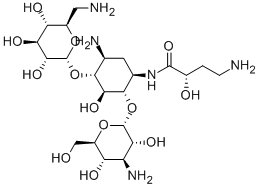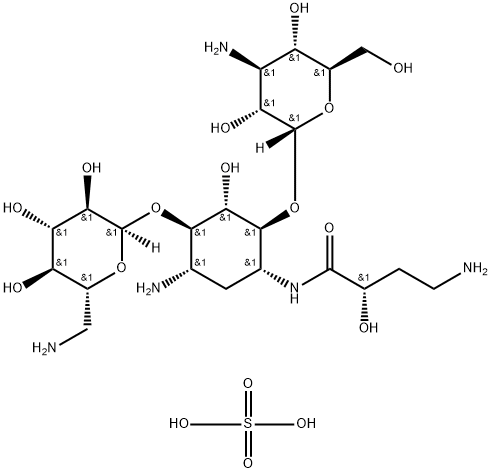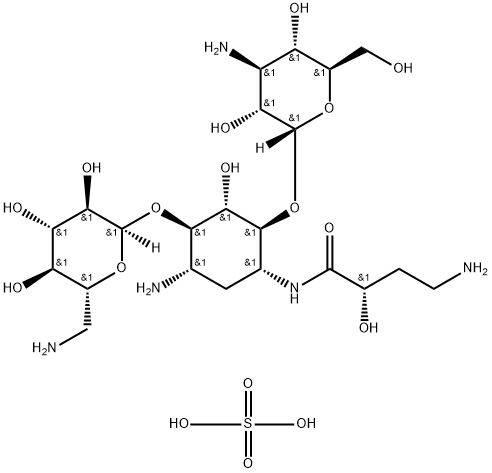Amikacin , 98% , 37517-28-5
Synonym(s):
Amikacin;N1-[(S)-4-Amino-2-hydroxybutyryl]kanamycin A
CAS NO.:37517-28-5
Empirical Formula: C22H43N5O13
Molecular Weight: 585.6
MDL number: MFCD00883675
EINECS: 253-538-5
| Pack Size | Price | Stock | Quantity |
| 250mg | RMB180.80 | In Stock |
|
| 1g | RMB590.40 | In Stock |
|
| 5g | RMB2200.00 | In Stock |
|
| others | Enquire |
PRODUCT Properties
| Melting point: | 203℃ |
| alpha | D23 +99° (c = 1.0 in water) |
| Boiling point: | 642.23°C (rough estimate) |
| Density | 1.3764 (rough estimate) |
| refractive index | 1.7500 (estimate) |
| storage temp. | 2-8°C |
| solubility | H2O: 50 mg/mL, clear, colorless |
| pka | pKa 8.1 (Uncertain) |
| form | solid |
| color | white to off-white |
| optical activity | 99(c 1.0) |
| Water Solubility | Soluble in water (partly). |
| Merck | 13,404 |
| BRN | 1445422 |
| Stability: | Hygroscopic |
| EPA Substance Registry System | Amikacin (37517-28-5) |
Description and Uses
Amikacin is made semisynthetically from kanamycin A. Interestingly, the L-hydroxyaminobutyryl amide (HABA) moiety attached to N-3 inhibits adenylation and phosphorylation in the distant amino sugar ring (at C-2′and C-3′), even though the HABA substituent is not where the enzymatic reaction takes place. This effect is attributed to decreased binding to the R factor–mediated enzymes.
Amikacin is a semi-synthetic derivative of kanamycin. It is much less sensitive to the enzymes that inactivate aminoglycoside antibiotics. The spectrum is similar to that of gentamicin. Amikacin principally finds use in the treatment of infections arising from bacteria that are resistant to gentamicin and/or tobramycin.
Safety
| Symbol(GHS) |  GHS07 |
| Signal word | Warning |
| Hazard statements | H317 |
| Precautionary statements | P280 |
| Hazard Codes | Xi |
| Risk Statements | 36/37/38 |
| Safety Statements | 26-36-24/25 |
| WGK Germany | 2 |
| RTECS | WK1955000 |
| F | 10-34 |
| HS Code | 29419090 |
| Hazardous Substances Data | 37517-28-5(Hazardous Substances Data) |
| Toxicity | LD50 in mice of solns pH 6.6, pH 7.4 (mg/kg): 340, 560 i.v. (Kawaguchi) |




